Most reliable "best" radio
-
I'd like to try one of these recently announced RFicient ultra low power receiver wake-up chips:
https://www.youtube.com/watch?v=bQINMRcoAsIIt claims a receive current of just 3 microamps and allegedly works in any of the 3 ISM bands.
Unfortunately, nothing yet on mouser or digikey. Who knows whether they'll actually deliver or whether they're just testing the market demand.
@NeverDie They claim that it is already available in a QFN16 package. https://www.iis.fraunhofer.de/en/ff/sse/ic-design/rf-ic/wakeup.html
But they say you have to go through "EBV Chips" to get it, and everything I've seen makes it look like that's for large companies only. I can get to this page at Avnet, https://www.avnet.com/wps/portal/ebv/solutions/ebvchips/ebvchips-overview/ but I can't seem to get past it to any chance to order or see a detailed datasheet or anything like that. A search just on regular Avnet for the part turns up empty with the things I can think of.
This is the best page I can come up with: https://www.avnet.com/wps/portal/ebv/solutions/ebvchips/rficient/ which is cool and all, but still nothing orderable for normal people.
-
Curiously, this keyfinder does appear to function fairly decently all the way down to 1.9v:
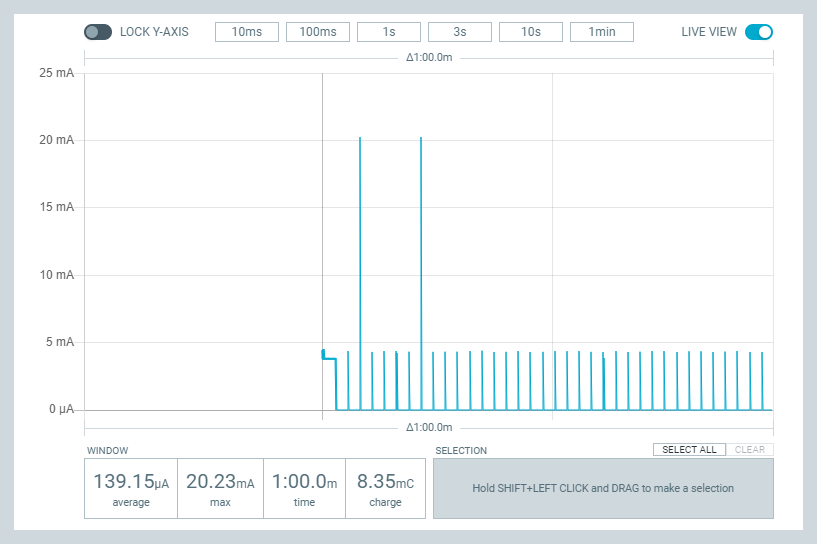
and its current draw actually drops to 29ua:
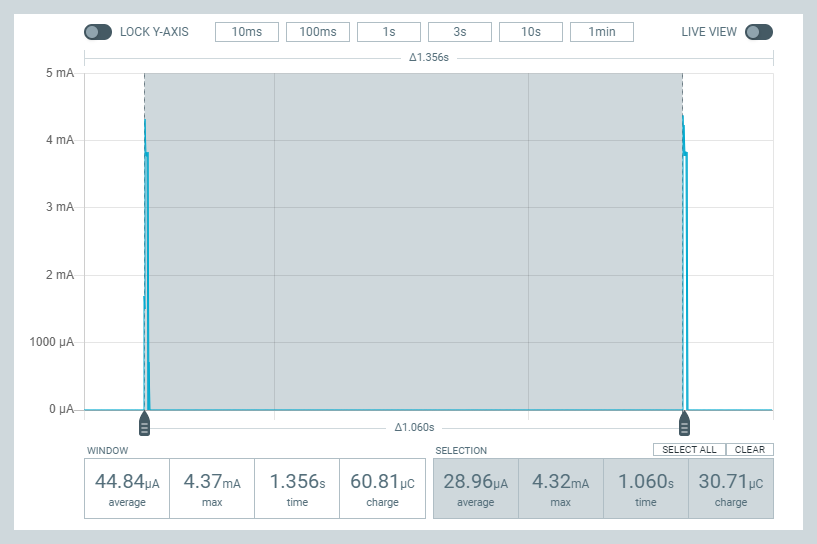
I'm including this screenshot of the Rx interval for completeness:

By the time it reaches 1.8v, it dies rapidly because it spends most of the 1 second duty cycle listening:
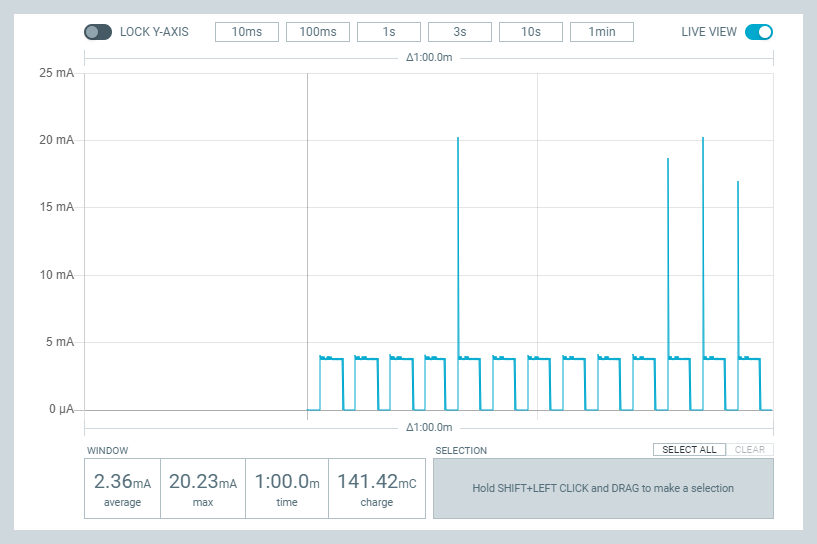
What the PPK2 doesn't do is simulate the voltage droop that a CR2032 can experience. Not at all sure what happens under those conditions, but maybe (probably?) it contributes to the seemingly short battery life. If that's the case, maybe these keyfinder receivers could be rehabilitated to last longer before needing a battery replacement.
By the way, when I checked the voltage remaining on the coincell taken from this keyfinder receive, it measures about 3mv. So, it got drained practically all the way to zero.
Anyhow, according to energizer, their CR2032 has 235mah of capacity when measured from fresh down to 2.0v (https://data.energizer.com/pdfs/cr2032.pdf). So, doing the math on that, assuming a 35ua burn rate, it should theoretically last 279 days, or about 9 months. That would be the lower bound. If one assumes 29ua as the burn rate, then it could last 11 months. That would be the upper bound. i.e. theoretically, it might last somewhere from 9-11 months. Definitely not two years. Also, I'm definitely got getting anything in that range on my keyfinder receiver tags--they die much sooner than that. I'm guessing it's CR2032 voltage droop that gets worse as the battery gets depleted which leads to premature failure. I wondering whether simply soldering in a suitably large value ceramic capacitor between VCC and GND might help it power through the droop and live up to its design potential? Better yet, I'd be willing to trade off responsiveness for much better battery life. Rather than checking once per second, maybe it could be modified to listen much less often than that.
-
Looking at the chips involved:

only one has markings on it:
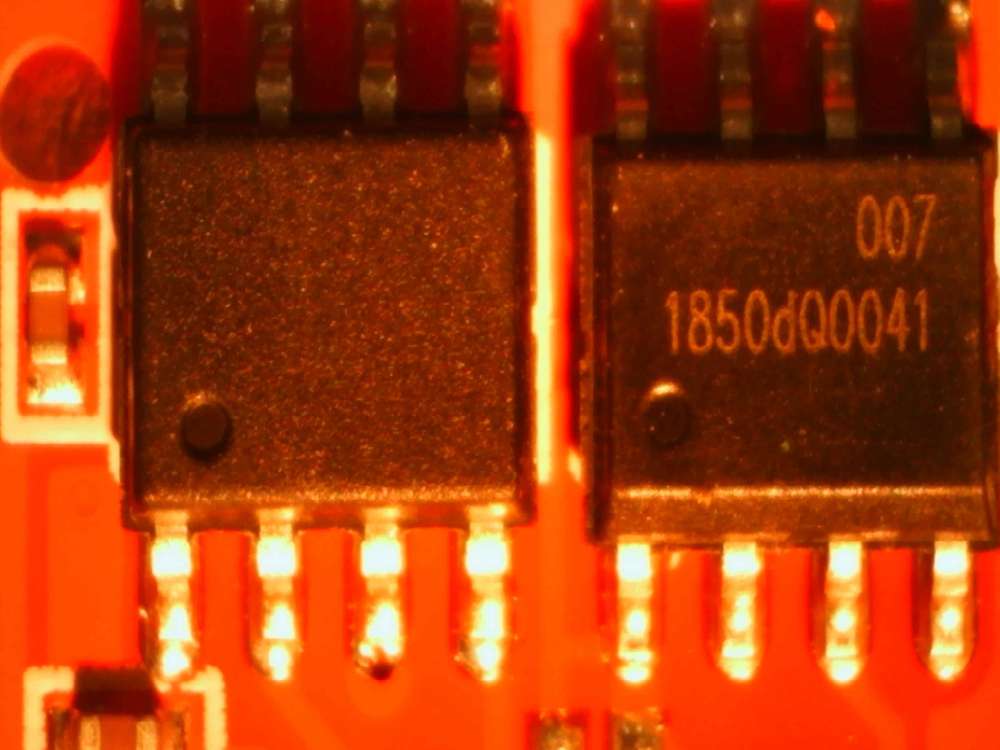
and that seems to return a null google result. So, it's a deadend in terms of modifying the receiver duty cycle.Maybe there are chips with actual datasheets for doing this kind of thing? The application is certainly nothing new.
-
This reminds me of an earlier tip that @mfalkvidd offered up here: https://forum.mysensors.org/topic/10806/how-is-this-receiver-able-to-continuously-rx-but-consume-only-90ua?_=1653861040283 for a chip that consumes only 1.37ua in listen mode.
That chip is now available (and in stock) via digikey: https://www.digikey.com/en/product-highlight/a/ams/as3930-low-frequency-wakeup-receiver?utm_adgroup=General&utm_source=google&utm_medium=cpc&utm_campaign=Dynamic Search_EN_RLSA&utm_term=&utm_content=General&gclid=EAIaIQobChMIg5OvvNmF-AIVzhXUAR2AXwVNEAAYASAAEgJG3vD_BwE
One possible catch is that it operates in a low frequency band that I know nothing about. If lucky, maybe that's a clean band set aside for this type of thing? On the face of it, it might make for a very long battery life keyfinder tag receiver, and compared to a Bluetooth TILE, the chip price isn't bad.
Maybe now is a good time to revisit this? Still in a bit of a quandary as to an easy way to test drive it. The eval kit actually went up in price to $333. There is a github library though for connecting an arduino to a related chip: https://github.com/LieBtrau/arduino-as3933
Also, another guy here: https://forum.digikey.com/t/as3933/2604/8 offers up a schematic and pcb layouts for connecting an as3933 to an atmega32u4. So, maybe taken together that does the business....provided you can find/make a suitable transmitter to activate it. In any case, from that same thread, what it appears to be is some kind of RF power envelope detector, which maybe explains the weird 100uvrms for expressing its sensitivity:

In other words, it's a more maybe a more sensitive version of a $2 RF Power detector:
https://www.youtube.com/watch?v=vHVmJ5lD9jcwhich is close range but is completely passive and so doesn't consume any power at all to "listen".
-
The listen mode I previously worked out on the nRF52832 pretty much blows away the performance of the cheap keyfinder receiver:
https://forum.mysensors.org/topic/6961/nrf5-action/1052?_=1653867854046
It had an Rx interval of just 30us and, aside from the startup time, the rest of the time, while sleeping, the current draw was <3ua. And it checked for packets once every 100ms, not once a second, so it was plenty responsive. If only the sleep current had been less. Perhaps in combination with a TPL5110 it would completely trump the battery life of the keyfinder tag. But, it's relatively expensive.That leaves the nRF24L01P. It draws 900na in powerdown mode, from which it takes 1.5ms to startup into standby mode, and from there only 130us to enter Rx mode. I'd say it has a chance for beating the keyfinder tag, because it could have a much shorter receive window than the ~8ms Rx window that the keyfinder tag has, even though the keyfinder tag appears to have a sleep current of nearly zero. What's the shortest valid packet that an nRF24L01 can receive? It turns out sparkfun had a (now retired) nRF24L01P keyfob, though they used it as a transmitter rather than as a keyfinder: https://www.sparkfun.com/products/retired/8602
-
For comparison, an nRF24L01 can, according to its datashet, cold-start from completely powered off to an idle state in 11.8ms. From there the remaining delay would mainly be the amount of time needed for the MCU to configure registers and load the transmit FIFO buffer. Not sure how long that takes. Anybody know? After that it would, in theory anyway, take just 130us to initiate the start of transmission.
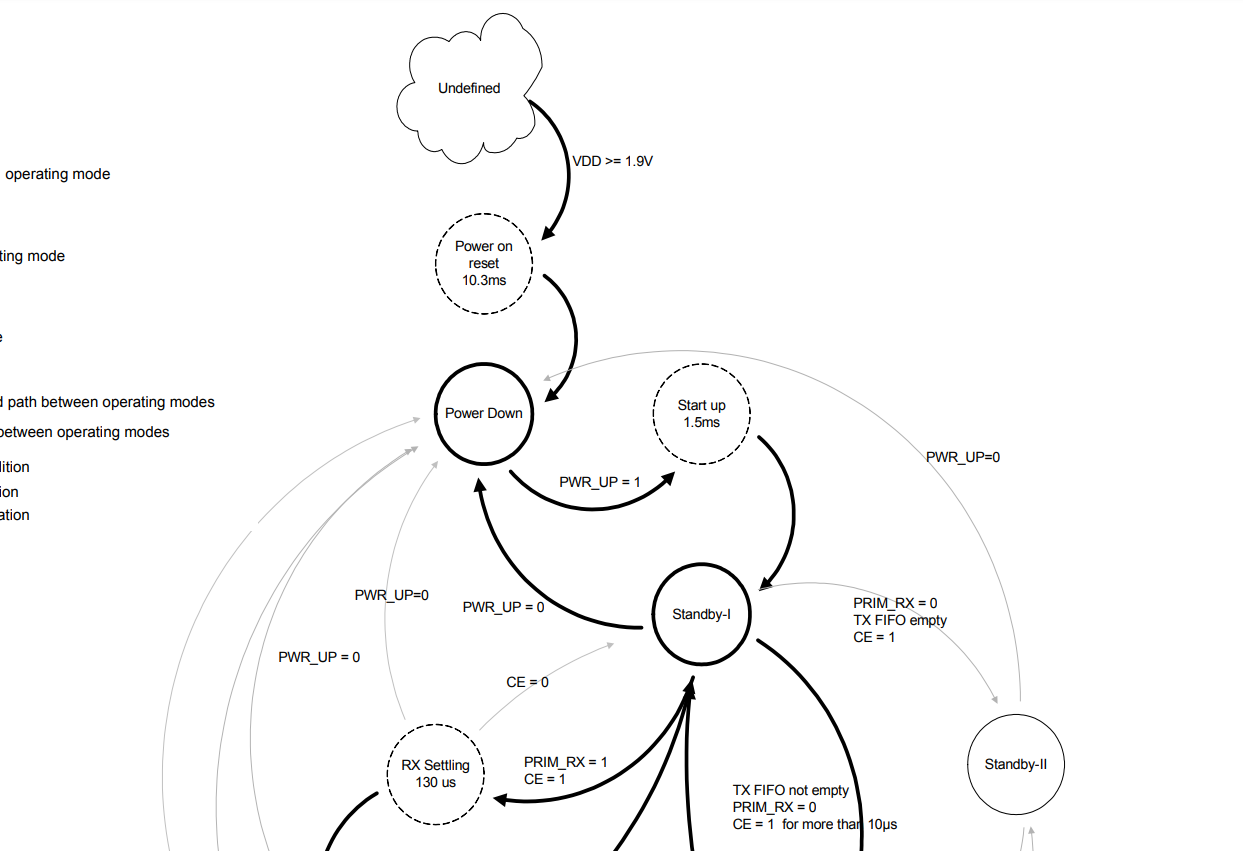
For that reason I'm guessing an nRF24L01 could, if it were an apples-to-apples comparison, have a much shorter transmission cycle than the 181.6ms transmission cycle of the Wemos D1 Mini ESP8266 that I measured above.Fun fact: the nrf5x modules have the advantage that they don't need to use SPI to load bytes into a transmission queue. Instead, when transmitting, an nRF5x can read the transmission bytes directly from memory via DMA.
In any case, comparing the SX1262 switching times, the SX1262 (LoRa) looks to be pretty fast:

Cold start to standby in 3.5ms, and then from standby to transmitting in 126us. As with the nrf24l01, the MCU will need to define registers and load the FIFO transmission queue before it can initiate the transmission, and that will take some amount of time because it happens over SPI.The SX1280 appears to have much faster transitions from sleep to idle than the SX1262, and practically an order of magnitude faster than the nRF24L01:

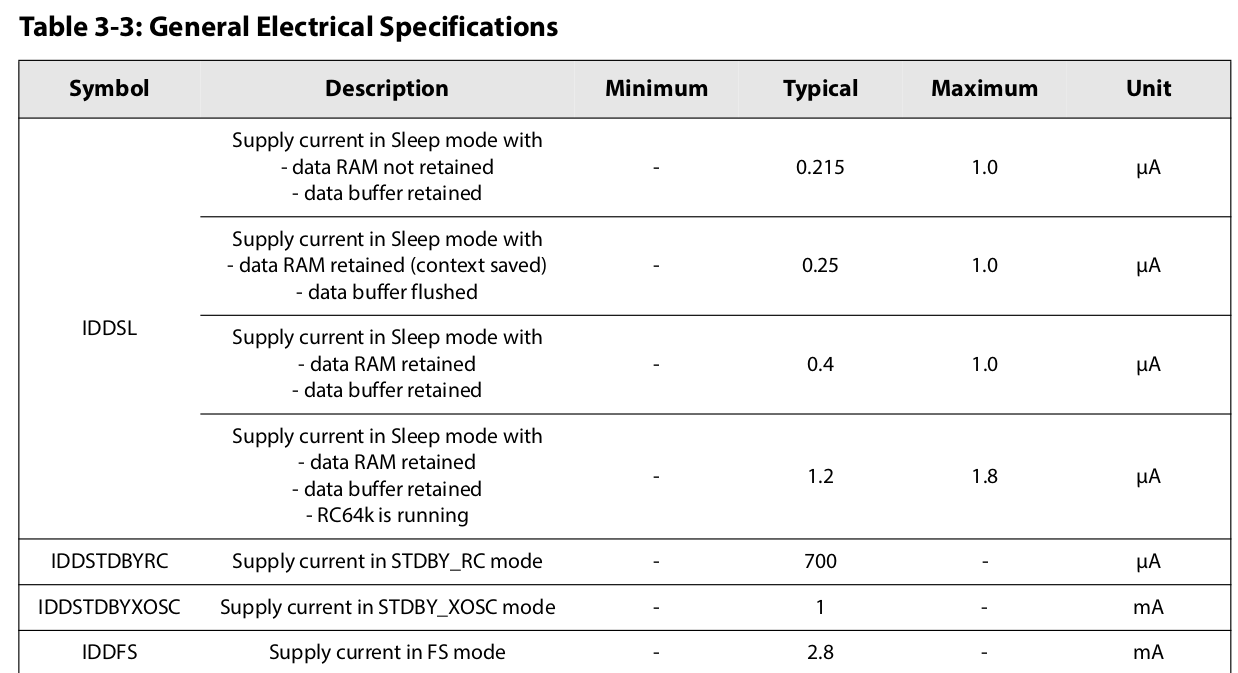
i.e. it can go from sleeping at a current of 1.2ua (maybe even 0.4ua?) with full data retention to Rx listening mode in 130+85 = 215us. That's pretty snappy. -
One big difference I hadn't realized until just now between the 2.4Ghz SX1280 and the sub-gigahertz SX1262 is that the SX1280 can utilize a bandwidth as wide as 1625KHz, whereas the SX1262 is limited to at most 500KHz. Why does that matter? Speed. The SX1280 can have a symbol time as low as 0.0197ms, whereas the fastest symbol time on the SX1262 is 0.064ms. That means the SX1280 can transmit 3.25x faster than the SX1262.
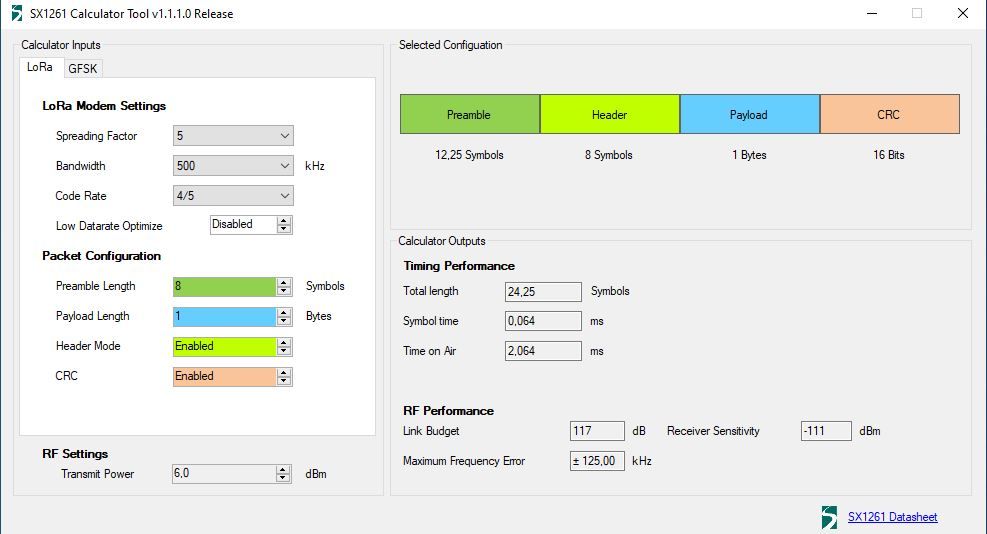
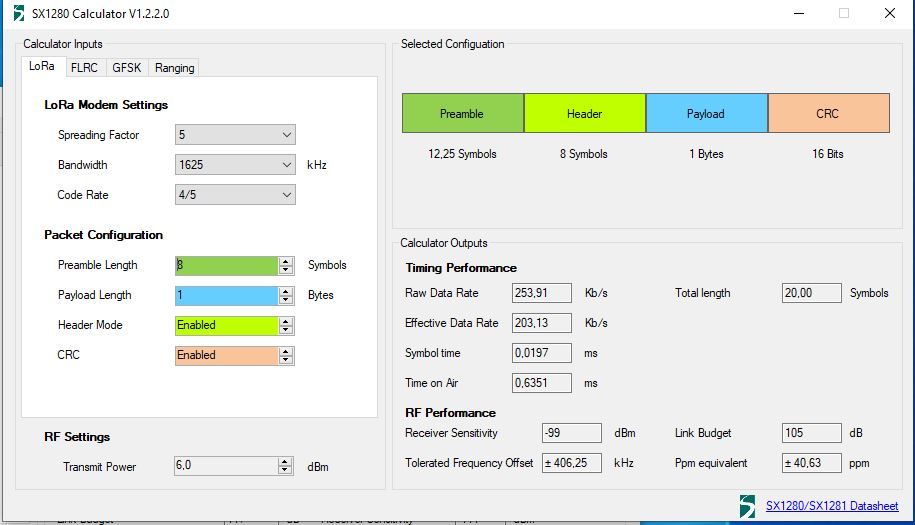
I confirmed this with a measurement on the SX1280 transmitting one byte (along with CRC-32 and all the other overhead that the library defaults to):

Add to that the faster transition times of the SX1280, and I conclude that at normal distances and transmission paths, the SX1280 is better suited for a battery powered mote that needs to duty-cycle listen for a wake-up packet than the SX1262 is.
By the way, observe the relatively high current draw on this particular SX1280. That is because of the 27dBm transmit power afforded by the PA of the Ebyte E28-2G4M27S module that it's a part of. That's why I made my own overkill usb-to-serial converter with a low-noise LDO that's rated to deliver as much as 1.1a at 3.3v, in case I'm powering the module that way. :-) The current draw that's in evidence in this snapshot would completely swamp the 50ma limit on most 3.3v USB-to-serial adapters on the market. Even Sparkfun's Beefy 3 is limited to 200ma, which is less than 1/3 the amount being drawn by the Ebyte module.
So, worst case, if I were to power the Ebyte module in Rx mode for 2ms per 1 second period, waiting for a 1 byte packet and all the overhead, that would translate into about 17ua average current draw, or a little over half of what my keyfinder fob draws.
However, by using the Channel Activity Detector (CAD), I should be able to reduce the wake-up detection window to about 4 symbol periods to reliably detect a LoRa transmission that overlaps its Rx window, which on an SX1280 would be 4*(0.0197ms)=0.0788ms. Let's round up and call that 0.1ms. Napkin math: that would maybe (?) translate into an average current draw that's under 4ua if one were to assume that, like the keyfinder fob, it listens only once per second and draws the worst-case 8.2ma while actively receiving in high-sensitivity mode and draws the worst-case 1.2ua while sleeping the rest of the time. Not bad! I say "maybe" because I'm not exactly sure how much it might draw while powering up and getting ready to receive. 0.1ms = 100us, so the current drawn during the 210us it takes for the SX1280 (and maybe longer for the Ebyte LNA?) to transition from sleep into Rx is going to affect the average current draw. With worst-case assumptions, the total shouldn't be more than an average current draw of 12ua, and I'd expect it to be much less than that. We know from the the SX1280 datasheet that Standby-RX mode draws 700ua, but clearly there must be some kind of ramping from the 1.2ua sleep current up to that amount, and between that amount and the 8.2ma when in receive mode. Therefore, I don't see a way to precisely calculate from just the datasheet alone. I could compute lower-bounds and upper-bounds or make some assumptions about the ramp rate, but to really remove the fog around this I think I'll write the duty-cycled listen code and then measure it with the PPK2.
Anyhow, this makes for yet another interesting point of comparison with the nRF24L01, or even the RFM69. The nRF24L01/RFM69 could maybe use RSSI threshold as a quick, short-hand way to judge whether a transmission might be occuring without having to go through a full packet receive cycle, but relying on RSSI alone for that purpose would tend to be sensitive to noise and interference, resulting in false positives. The CAD of the SX1280, in contrast, is designed to detect LoRa transmissions specifically, so hopefully it will filter out that kind of noise, or, at minimum, at least not false positive trigger on it. That's especially important for the SX1280, which operates in the crowded 2.4GHz band.
Another advantage of the SX1280, as compared to the SX1262, is that the SX1280 can run its DCDC converter in RX and TX modes, whereas the SX1262 is limited to LDO only, so that's another way the SX1280 can get longer battery life.
-
Using RadioLib on the SX1280 Ebyte module, I was able to get the CAD working at 1 second intervals:
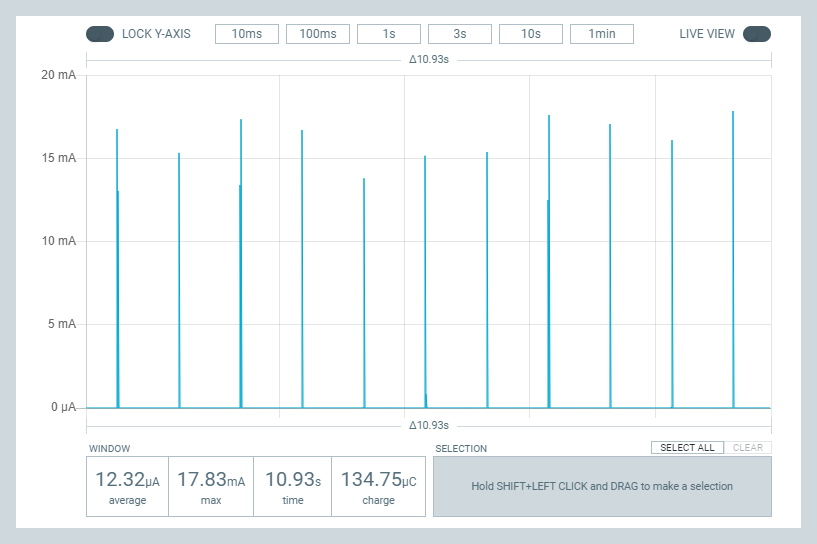
I picked 1 second to make for an apples-to-apples comparison against the Keyfinder fob above.
Zooming in to the area of interest:
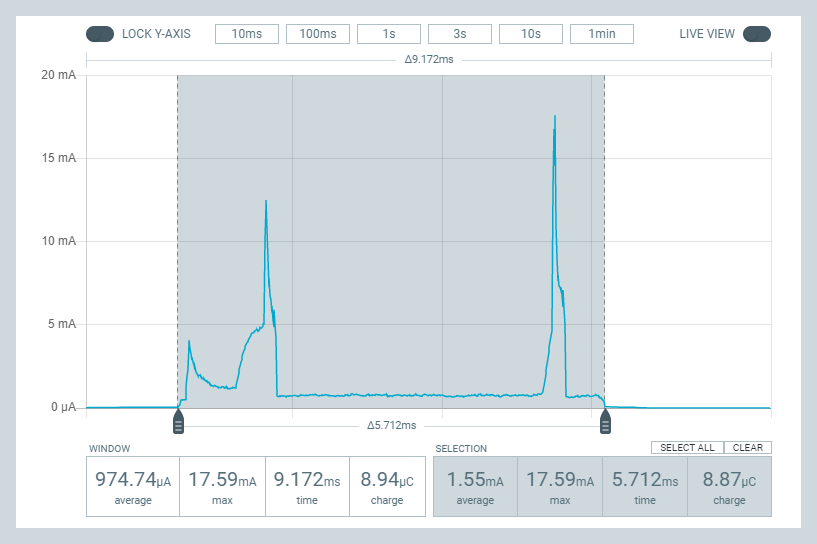
This screenshot shows the average current consumed while waking up, re-establishing the radio configuration, and then doing the CAD. I reduced the spreading factor to SF5, and I increased the bandwidth to 1625Mhz. Also, in the RadioLib library, DC-DC conversion on the SX1280 is turned on by default. I expect the results shown could be improved upon with more careful programming, but as a first-pass the results are: it could last 2.8 years on a CR2032 coincell. That is using RadioLib's default 8 symbols for judging a CAD. So, as a first-pass, not bad! It definitely beats the projected 9-11 month battery lifespan on the keyfinder fob from above. I'm reasonably sure that lifespan could be improved using more careful programming to reduce the SX1280 radio configuration time after waking up. In theory, the SX1280 is supposed to remember its configuration in one of the two sleep modes, but, in practice, it seems to be forgetting at least some of it, so for a quick first-pass workaround I do a full re-configuration each time it wakes up. -
I'm getting no traction on this thread so I think I may move this topic to some other forum on some other website. Sorry. Maybe this is just the wrong place for it, or maybe the topic is of no interest to others here. Whatever the reason, monologging is no fun. There just isn't the feedback or comments or suggestions to make further posting on this topic worthwhile.
End of thread.
-
Bingo! Scored it. Captured below is a single transmission using the Adafruit TPL5110 to power up a Wemos D1 Mini ESP8266 from essentially nothing (43na) and then return to essentially nothing (43na) afterward. So, this screenshot captures the entire process for an ESP8266 that's in ESP-NOW mode.

Here is the sketch that I used:/**************************************************************************************************************************************************** * TITLE: ESP-NOW Getting Started Examples * * By Frenoy Osburn * YouTube Video: https://youtu.be/_cNAsTB5JpM ****************************************************************************************************************************************************/ /******************************************************************************************************************** * Please make sure that you install the board support package for the ESP8266 boards. * You will need to add the following URL to your Arduino preferences. * Boards Manager URL: http://arduino.esp8266.com/stable/package_esp8266com_index.json ********************************************************************************************************************/ /******************************************************************************************************************** * Board Settings: * Board: "WeMos D1 R1 or Mini" * Upload Speed: "921600" * CPU Frequency: "80MHz" * Flash Size: "4MB (FS:@MB OTA:~1019KB)" * Debug Port: "Disabled" * Debug Level: "None" * VTables: "Flash" * IwIP Variant: "v2 Lower Memory" * Exception: "Legacy (new can return nullptr)" * Erase Flash: "Only Sketch" * SSL Support: "All SSL ciphers (most compatible)" * COM Port: Depends *On Your System* *********************************************************************************************************************/ #include<ESP8266WiFi.h> #include<espnow.h> #define MY_NAME "CONTROLLER_NODE" #define MY_ROLE ESP_NOW_ROLE_CONTROLLER // set the role of this device: CONTROLLER, SLAVE, COMBO #define RECEIVER_ROLE ESP_NOW_ROLE_SLAVE // set the role of the receiver #define WIFI_CHANNEL 1 uint8_t receiverAddress[] = {0xFF, 0xFF, 0xFF, 0xFF, 0xFF, 0xFF}; // please update this with the MAC address of the receiver struct __attribute__((packed)) dataPacket { int sensor1; int sensor2; float sensor3; }; void transmissionComplete(uint8_t *receiver_mac, uint8_t transmissionStatus) { if(transmissionStatus == 0) { //Serial.println("Data sent successfully"); digitalWrite(14,HIGH); } else { //Serial.print("Error code: "); //Serial.println(transmissionStatus); } } dataPacket packet; void setup() { pinMode(14,OUTPUT); digitalWrite(14,LOW); //Serial.begin(115200); // initialize serial port //Serial.println(); //Serial.println(); //Serial.println(); //Serial.print("Initializing..."); //Serial.println(MY_NAME); //Serial.print("My MAC address is: "); //Serial.println(WiFi.macAddress()); WiFi.mode(WIFI_STA); WiFi.disconnect(); // we do not want to connect to a WiFi network if(esp_now_init() != 0) { //Serial.println("ESP-NOW initialization failed"); return; } esp_now_set_self_role(MY_ROLE); esp_now_register_send_cb(transmissionComplete); // this function will get called once all data is sent esp_now_add_peer(receiverAddress, RECEIVER_ROLE, WIFI_CHANNEL, NULL, 0); packet.sensor1 = 123; //Serial.println("Initialized."); } void loop() { packet.sensor1++; packet.sensor2 = 456; packet.sensor3 = 3.14; esp_now_send(receiverAddress, (uint8_t *) &packet, sizeof(packet)); delay(1000); }It is only slightly modified from the original. Essentially I commented-out all of the code relating to print statements, because that would drag out the time and is superfluous for present purposes, and I set GPIO14 to high as the "DONE" signal after the packet was finished sending and the related callback function was called, which instructed the TPL5110 to cut the power.
So, I finally have the data now to do the necessary battery calculation. Crunching the numbers, assuming a single transmission like this every 5 minutes, the batteries would last almost 19 years. That is just a pure packet transmission with no acknowledgement. Still, it is much better than what I had been expecting based on what others have reported.
It might be that this could be improved upon by removing the ESP8266 from its Wemos D1 Mini PCB, as the PCB contains components which may be soaking up power and simply aren't needed. Also, looking at the current graph, it looks as though maybe it's listening after the main transmission? Maybe someone knowledgeable about ESP-NOW can comment. Lastly, I'm not sure what datarate ESP-NOW defaults to. Maybe it would be possible to have it transmit faster and thereby use less current. So, lots to look into if anyone here has the interest.
Anyhow, I think that this proves the concept. Who knew? All this time the ESP8266 had been type-cast as impossibly power hungry. I guess the main downside is that anything in addition that one might do, such as measuring the battery voltage or doing an TH measurement, as examples, will be done at a fairly high current burnrate. Offsetting that might (?) be the prospect of getting it done sooner.
The real question, though, is whether it makes sense to do a similar measurement on an ESP32, and, if so, which one? Any chance it would be better? Or would it likely be worse?
@NeverDie said in Most reliable "best" radio:
All this time the ESP8266 had been type-cast as impossibly power hungry. I guess the main downside is that anything in addition that one might do, such as measuring the battery voltage or doing an TH measurement, as examples, will be done at a fairly high current burnrate.
By turning off the 8266's radio and only using the CPU for TH, voltage, or any other measurement, considerable power savings result. I think I was getting down to the mid-teens of mA, instead of the 70 mA or so with the radio on. Another power savings came to me by saving up periodic readings, in like a table. Then every 50th reading, or so, turn radio back on and do a bulk-load to whatever database is desired, then turn off the radio and go to sleep. It was a kick to learn how to do this. Here is a posting I did at mathworks with more detail as it relates to loading to Thingspeak: https://www.mathworks.com/support/search.html/answers/890382-how-to-efficiently-transfer-bulk-upload-from-an-esp8266-to-thingspeak.html?fq[]=asset_type_name:answer&fq[]=category:thingspeak/write-data&page=1
I've seen several other uses of the ESP that exclude radio use and just implement the CPU. -
I'm getting no traction on this thread so I think I may move this topic to some other forum on some other website. Sorry. Maybe this is just the wrong place for it, or maybe the topic is of no interest to others here. Whatever the reason, monologging is no fun. There just isn't the feedback or comments or suggestions to make further posting on this topic worthwhile.
End of thread.
@NeverDie said in Most reliable "best" radio:
I'm getting no traction here so I think I may move this to some other forum on some other website. Sorry. Maybe this is just the wrong place for it, or maybe the topic is of no interest to others here. Whatever the reason, monologging is no fun. There just isn't the feedback or comments or suggestions to make further posting on this topic worthwhile.
End of thread.Just saw this after my last post. Well, sorry to see this end and thank you for all the work. I've been so consumed on your SX1280 thread, and buying equipment that I haven't been back for a while. Regrets.
-
Curiously, this keyfinder does appear to function fairly decently all the way down to 1.9v:

and its current draw actually drops to 29ua:

I'm including this screenshot of the Rx interval for completeness:

By the time it reaches 1.8v, it dies rapidly because it spends most of the 1 second duty cycle listening:

What the PPK2 doesn't do is simulate the voltage droop that a CR2032 can experience. Not at all sure what happens under those conditions, but maybe (probably?) it contributes to the seemingly short battery life. If that's the case, maybe these keyfinder receivers could be rehabilitated to last longer before needing a battery replacement.
By the way, when I checked the voltage remaining on the coincell taken from this keyfinder receive, it measures about 3mv. So, it got drained practically all the way to zero.
Anyhow, according to energizer, their CR2032 has 235mah of capacity when measured from fresh down to 2.0v (https://data.energizer.com/pdfs/cr2032.pdf). So, doing the math on that, assuming a 35ua burn rate, it should theoretically last 279 days, or about 9 months. That would be the lower bound. If one assumes 29ua as the burn rate, then it could last 11 months. That would be the upper bound. i.e. theoretically, it might last somewhere from 9-11 months. Definitely not two years. Also, I'm definitely got getting anything in that range on my keyfinder receiver tags--they die much sooner than that. I'm guessing it's CR2032 voltage droop that gets worse as the battery gets depleted which leads to premature failure. I wondering whether simply soldering in a suitably large value ceramic capacitor between VCC and GND might help it power through the droop and live up to its design potential? Better yet, I'd be willing to trade off responsiveness for much better battery life. Rather than checking once per second, maybe it could be modified to listen much less often than that.
@NeverDie said in Most reliable "best" radio:
By the way, when I checked the voltage remaining on the coincell taken from this keyfinder receive, it measures about 3mv. So, it got drained practically all the way to zero.
I've seen this when playing with 328's and 8266's. When voltages drop to the min threshold, the devices fail into a funky state drawing big current. For that reason, my current designs give out a yelp at a moderately low voltage, if there is a radio attached. Then go into deep sleep hoping that a rescue arrives. Deep discharges are really problematic for rechargeable liOn batteries. The advice is to abandon the battery because of potential changes to chemistry and the risk of fire on recharge.
-
@NeverDie said in Most reliable "best" radio:
By the way, when I checked the voltage remaining on the coincell taken from this keyfinder receive, it measures about 3mv. So, it got drained practically all the way to zero.
I've seen this when playing with 328's and 8266's. When voltages drop to the min threshold, the devices fail into a funky state drawing big current. For that reason, my current designs give out a yelp at a moderately low voltage, if there is a radio attached. Then go into deep sleep hoping that a rescue arrives. Deep discharges are really problematic for rechargeable liOn batteries. The advice is to abandon the battery because of potential changes to chemistry and the risk of fire on recharge.
@Larson said in Most reliable "best" radio:
@NeverDie said in Most reliable "best" radio:
By the way, when I checked the voltage remaining on the coincell taken from this keyfinder receive, it measures about 3mv. So, it got drained practically all the way to zero.
I've seen this when playing with 328's and 8266's. When voltages drop to the min threshold, the devices fail into a funky state drawing big current. For that reason, my current designs give out a yelp at a moderately low voltage, if there is a radio attached. Then go into deep sleep hoping that a rescue arrives. Deep discharges are really problematic for rechargeable liOn batteries. The advice is to abandon the battery because of potential changes to chemistry and the risk of fire on recharge.
What kind of device/component do you use to make the yelp sound? I've looked for tiny piezo's that could maybe do this, but they all seem to be different degrees of large. I know it should be possible to be tiny, becaue, for example, a digital wristwatch is able to make audible beeps. On the other hand, after looking at some teardowns, I guess digital watches uses piezo disks that are at least 1/2" in diameter. Hmmmm.... Is that really as small as it gets? Anyone here know? What about hearing aids? Surely they have something smaller. The smallest thing I've found so far has been this: https://owolff.com/page140.aspx?recordid140=534&output=pdf&delay=3000&margin=1cm which is 5mm in diameter. So, I guess forget mounting anything directly to the PCB board: wired discs are the way it's done apparently and then just tuck it somewhere inside the project enclosure.
-
@Larson said in Most reliable "best" radio:
@NeverDie said in Most reliable "best" radio:
By the way, when I checked the voltage remaining on the coincell taken from this keyfinder receive, it measures about 3mv. So, it got drained practically all the way to zero.
I've seen this when playing with 328's and 8266's. When voltages drop to the min threshold, the devices fail into a funky state drawing big current. For that reason, my current designs give out a yelp at a moderately low voltage, if there is a radio attached. Then go into deep sleep hoping that a rescue arrives. Deep discharges are really problematic for rechargeable liOn batteries. The advice is to abandon the battery because of potential changes to chemistry and the risk of fire on recharge.
What kind of device/component do you use to make the yelp sound? I've looked for tiny piezo's that could maybe do this, but they all seem to be different degrees of large. I know it should be possible to be tiny, becaue, for example, a digital wristwatch is able to make audible beeps. On the other hand, after looking at some teardowns, I guess digital watches uses piezo disks that are at least 1/2" in diameter. Hmmmm.... Is that really as small as it gets? Anyone here know? What about hearing aids? Surely they have something smaller. The smallest thing I've found so far has been this: https://owolff.com/page140.aspx?recordid140=534&output=pdf&delay=3000&margin=1cm which is 5mm in diameter. So, I guess forget mounting anything directly to the PCB board: wired discs are the way it's done apparently and then just tuck it somewhere inside the project enclosure.
@NeverDie said in Most reliable "best" radio:
What kind of device/component do you use to make the yelp sound?
My present "Yelp" design comes from a Thingspeak script that sends an email. Yelp may have been the wrong word, but I was thinking of smoke detectors that beep to say, "I'm dying, replace my battery". Previously, I built a WiFi mouse trap that sent email/text/phonecall via SMTP2GO if the trap was tripped (mouse, or no mouse). That was fun! That code could easily be modified to trigger on a voltage threshold, or any other variable.
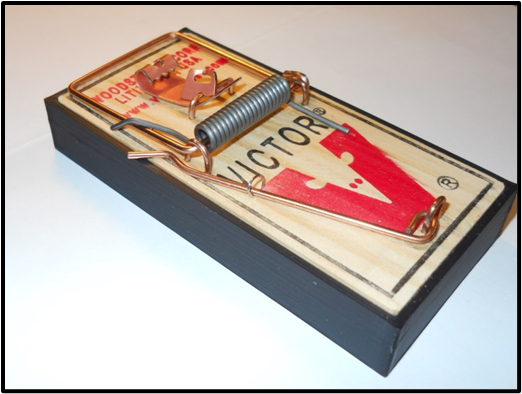 image url)
image url) -
@NeverDie said in Most reliable "best" radio:
What kind of device/component do you use to make the yelp sound?
My present "Yelp" design comes from a Thingspeak script that sends an email. Yelp may have been the wrong word, but I was thinking of smoke detectors that beep to say, "I'm dying, replace my battery". Previously, I built a WiFi mouse trap that sent email/text/phonecall via SMTP2GO if the trap was tripped (mouse, or no mouse). That was fun! That code could easily be modified to trigger on a voltage threshold, or any other variable.
 image url)
image url)@Larson That's a nice, clean looking, elegant design. If you have any idea on how to kill skunks, let me know. They are destroying my lawn. Live capture doesn't seem practical for skunks, for obvious reasons. I've seen one youtube that demonstrates a deadfall device--and proves it works--but it's the only example I've managed to find. There do exist professional services, but they charge a couple hundred bucks per animal removed, but after removal they can't legally release them (because they are officially pests), so the pro's just end up killing them anyway.
-
@Larson That's a nice, clean looking, elegant design. If you have any idea on how to kill skunks, let me know. They are destroying my lawn. Live capture doesn't seem practical for skunks, for obvious reasons. I've seen one youtube that demonstrates a deadfall device--and proves it works--but it's the only example I've managed to find. There do exist professional services, but they charge a couple hundred bucks per animal removed, but after removal they can't legally release them (because they are officially pests), so the pro's just end up killing them anyway.
@NeverDie For skunks, and racoons I use an electric fence. I string a wire around the lawns & ferns about 6" up from grade using non-conducting stakes. I think it works and is non-lethal. The e-fence was the smallest Coastal Farm offers. Our cat has 'figured' it out and knows to stay away.
In the spirit of radio electronics, I did build a system for mole elimination. It was complicated. I use a vibration detector/WiFi (ESPNOW) that sends notice to a piezo beeper inside the house. The detector is planted in the last active mole pile. If I hear the beeper I jump to action to hit a button (Transmit/Recieve pair) to ignite an electronic firecracker that would be burried in the last visited mole pile. I could have automated that button-pushing task, but the extra human control made it safer and more entertaining. The firecracker is be fitted with a nicrome wire fork, inplace of the normal fuse. The firecrackers I prepared were painted in some waterproof paint to keep them from degrading in the moist soil. An 18V Ryobi tool battery is used for the power source in the relay circuit because that gives enough juice to burn the nicrome wire. I tested it but have yet to deploy it. Here is the circuit for the igniter. image url)
image url) -
@NeverDie For skunks, and racoons I use an electric fence. I string a wire around the lawns & ferns about 6" up from grade using non-conducting stakes. I think it works and is non-lethal. The e-fence was the smallest Coastal Farm offers. Our cat has 'figured' it out and knows to stay away.
In the spirit of radio electronics, I did build a system for mole elimination. It was complicated. I use a vibration detector/WiFi (ESPNOW) that sends notice to a piezo beeper inside the house. The detector is planted in the last active mole pile. If I hear the beeper I jump to action to hit a button (Transmit/Recieve pair) to ignite an electronic firecracker that would be burried in the last visited mole pile. I could have automated that button-pushing task, but the extra human control made it safer and more entertaining. The firecracker is be fitted with a nicrome wire fork, inplace of the normal fuse. The firecrackers I prepared were painted in some waterproof paint to keep them from degrading in the moist soil. An 18V Ryobi tool battery is used for the power source in the relay circuit because that gives enough juice to burn the nicrome wire. I tested it but have yet to deploy it. Here is the circuit for the igniter. image url)
image url)@Larson Will a firecracker actually kill a mole? This guy shows off his simple contraption that uses 500v to instantly kill rodents:
https://www.youtube.com/watch?v=-xkOtVlDUbwThe key seems to be charging high voltage capacitors, so that enough current is released at 500v when triggered. I know: dangerous as hell, but maybe this is where your wireless human-in-the-loop firing trigger could come into play so that it doesn't kill anything that it's not supposed to.
He says it's highly effective.
I don't know whether something like that would work for moles or not. I guess it depends on whether they ever leave their holes to look for food or whether they stay underground all the time.
I wouldn't feel comfortable walking up to something charged to 500v, but maybe that's where radio electronics could completely disarm it down to zero volts when commanded before you even think of touching it. His is more basic and doesn't have that added feature. I would want redundant everything on the safety features so that there's no chance of it going wrong.
As for charging it up, I think one of these would work for fairly cheap:
https://www.amazon.com/gp/product/B07JG4K6S6/ref=ppx_yo_dt_b_search_asin_title?ie=UTF8&psc=1
as long as you terminate the charge when it gets to 500v and not let it continue on to 15,000 volts, which would destroy your charge capacitor. Since it comes in a pack of two, maybe the other one could be used to energize an electric fence? I know nothing about electric fences or what voltage they use, but I would hazard a guess that the circuitry is similar (flyback transformer design), and then all you would need is the right kind of wire and some insulated stakes.An electric fence is an interesting idea, provided it doesn't ignite dead leaves and create a fire. Not sure whether or not that's even a risk. I presume that professional electric fences wouldn't do that.
-
@NeverDie For skunks, and racoons I use an electric fence. I string a wire around the lawns & ferns about 6" up from grade using non-conducting stakes. I think it works and is non-lethal. The e-fence was the smallest Coastal Farm offers. Our cat has 'figured' it out and knows to stay away.
In the spirit of radio electronics, I did build a system for mole elimination. It was complicated. I use a vibration detector/WiFi (ESPNOW) that sends notice to a piezo beeper inside the house. The detector is planted in the last active mole pile. If I hear the beeper I jump to action to hit a button (Transmit/Recieve pair) to ignite an electronic firecracker that would be burried in the last visited mole pile. I could have automated that button-pushing task, but the extra human control made it safer and more entertaining. The firecracker is be fitted with a nicrome wire fork, inplace of the normal fuse. The firecrackers I prepared were painted in some waterproof paint to keep them from degrading in the moist soil. An 18V Ryobi tool battery is used for the power source in the relay circuit because that gives enough juice to burn the nicrome wire. I tested it but have yet to deploy it. Here is the circuit for the igniter. image url)
image url)@Larson Do you have any links to this please? I found next doors 2 new cats killing 2 young birds they had paicked out of the tree and onto my lawn. The owners are un-cooperative on the issue and the cats have been using my garden as their own litter tray..... Garlic, chilli powder and vinegar have had no effect so I need to up the game!
-
@Larson Do you have any links to this please? I found next doors 2 new cats killing 2 young birds they had paicked out of the tree and onto my lawn. The owners are un-cooperative on the issue and the cats have been using my garden as their own litter tray..... Garlic, chilli powder and vinegar have had no effect so I need to up the game!
-
@Larson Will a firecracker actually kill a mole? This guy shows off his simple contraption that uses 500v to instantly kill rodents:
https://www.youtube.com/watch?v=-xkOtVlDUbwThe key seems to be charging high voltage capacitors, so that enough current is released at 500v when triggered. I know: dangerous as hell, but maybe this is where your wireless human-in-the-loop firing trigger could come into play so that it doesn't kill anything that it's not supposed to.
He says it's highly effective.
I don't know whether something like that would work for moles or not. I guess it depends on whether they ever leave their holes to look for food or whether they stay underground all the time.
I wouldn't feel comfortable walking up to something charged to 500v, but maybe that's where radio electronics could completely disarm it down to zero volts when commanded before you even think of touching it. His is more basic and doesn't have that added feature. I would want redundant everything on the safety features so that there's no chance of it going wrong.
As for charging it up, I think one of these would work for fairly cheap:
https://www.amazon.com/gp/product/B07JG4K6S6/ref=ppx_yo_dt_b_search_asin_title?ie=UTF8&psc=1
as long as you terminate the charge when it gets to 500v and not let it continue on to 15,000 volts, which would destroy your charge capacitor. Since it comes in a pack of two, maybe the other one could be used to energize an electric fence? I know nothing about electric fences or what voltage they use, but I would hazard a guess that the circuitry is similar (flyback transformer design), and then all you would need is the right kind of wire and some insulated stakes.An electric fence is an interesting idea, provided it doesn't ignite dead leaves and create a fire. Not sure whether or not that's even a risk. I presume that professional electric fences wouldn't do that.
@NeverDie said in Most reliable "best" radio:
Will a firecracker actually kill a mole?
I'm not sure. But the MoleCat100 uses the blast from a 22 blank, and that has to be close to the concussive force of a firecracker. Being under the dirt by about 4" has to also help in rendering an effective shock wave since dirt is far less compressible than air.
@NeverDie said in Most reliable "best" radio:
The key seems to be charging high voltage capacitors, so that enough current is released at 500v when triggered.
Smoking Cool, and yea, probably dangerous. I was playing with flash bulb circuits from disposable cameras as a potential igniter. I accidently shorted a loaded circuit, and the thing burned a hole in my screw driver. Stunned and temporarily blinded, I put it away immediately and haven't gone back since. I don't think the 500 V device would work on moles; they do their foraging in their tunnels. Probably grubs and worms. Maybe they come out at night?
MouseTrapMonday has probably featured this 500 V device. He has quite a collection.
The Comidox 15KV looks like fun, and again dangerous. Glad to see that the thing comes disassembled. Assembly provides some knowledge requirement at least.
My electric fence is this one. It seems to have internal circuitry that limits grounding problems. The thing sends pulses at about 1Hz. Using a blade of grass, or green straw one can feel the pulses. I've had branches fall on the fence and pin it to the ground without resulting in problems so far. It would be fun to do a tear-down to learn how they work... but I've got these radios to play with.
